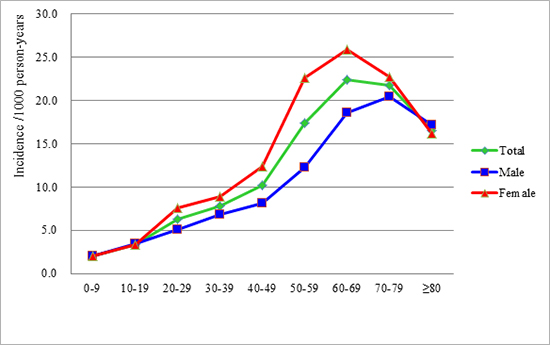1. Johnson RW. Herpes zoster and postherpetic neuralgia. Expert Rev Vaccines. 2010; 9:21–26.
2. McElhaney JE. Herpes zoster: a common disease that can have a devastating impact on patients' quality of life. Expert Rev Vaccines. 2010; 9:27–30.
3. Oxman MN, Levin MJ, Johnson GR, Schmader KE, Straus SE, Gelb LD, Arbeit RD, Simberkoff MS, Gershon AA, Davis LE, et al. A vaccine to prevent herpes zoster and postherpetic neuralgia in older adults. N Engl J Med. 2005; 352:2271–2284.
4. Schmader KE, Levin MJ, Gnann JW Jr, McNeil SA, Vesikari T, Betts RF, Keay S, Stek JE, Bundick ND, Su SC, et al. Efficacy, safety, and tolerability of herpes zoster vaccine in persons aged 50-59 yr. Clin Infect Dis. 2012; 54:922–928.
5. Park SY, Kim JY, Kim CD, Kim CW, Lee KS. A clinical study on herpes zoster during the last 10-yr-period (1994-2003). Korean J Dermatol. 2004; 42:1531–1535.
6. Kim YM, Lee SY, Lee JS, Park YL, Whang KU, Cho MK, Park EJ. Epidemiological and clinical study on herpes zoster in the province of Chungcheongnam-do (2004~2006). Korean J Dermatol. 2008; 46:1488–1494.
7. Kim JW, Kim SY, Lee KW, Houh W, Cho OJ, Lee SW. A clinical study on herpes zoster and chicken pox. Korean J Dermatol. 1982; 20:69–76.
8. Health Insurance Review & Assessment Service. HIRA-NPS 0067. Seoul: Health Insurance Review & Assessment Service;2011.
9. Yawn BP, Gilden D. The global epidemiology of herpes zoster. Neurology. 2013; 81:928–930.
12. Yawn BP, Saddier P, Wollan PC, St Sauver JL, Kurland MJ, Sy LS. A population-based study of the incidence and complication rates of herpes zoster before zoster vaccine introduction. Mayo Clin Proc. 2007; 82:1341–1349.
13. Chao DY, Chien YZ, Yeh YP, Hsu PS, Lian IB. The incidence of varicella and herpes zoster in Taiwan during a period of increasing varicella vaccine coverage, 2000-2008. Epidemiol Infect. 2012; 140:1131–1140.
14. Gauthier A, Breuer J, Carrington D, Martin M, Rémy V. Epidemiology and cost of herpes zoster and post-herpetic neuralgia in the United Kingdom. Epidemiol Infect. 2009; 137:38–47.
15. Gialloreti LE, Merito M, Pezzotti P, Naldi L, Gatti A, Beillat M, Serradell L, di Marzo R, Volpi A. Epidemiology and economic burden of herpes zoster and post-herpetic neuralgia in Italy: a retrospective, population-based study. BMC Infect Dis. 2010; 10:230.
16. Thomas SL, Hall AJ. What does epidemiology tell us about risk factors for herpes zoster? Lancet Infect Dis. 2004; 4:26–33.









 PDF
PDF ePub
ePub Citation
Citation Print
Print









 XML Download
XML Download